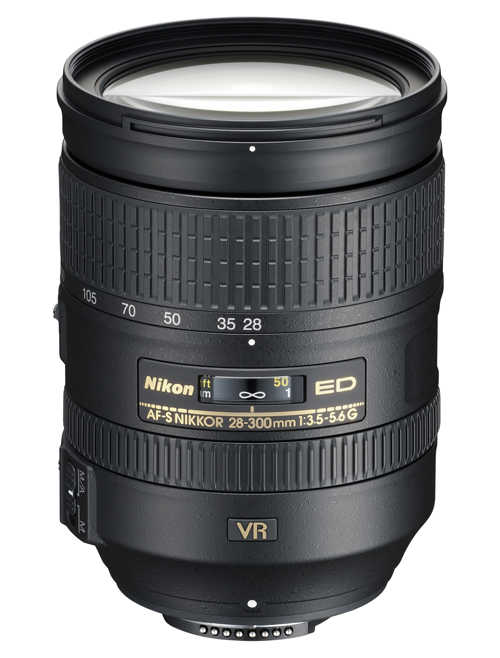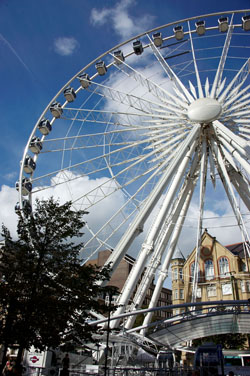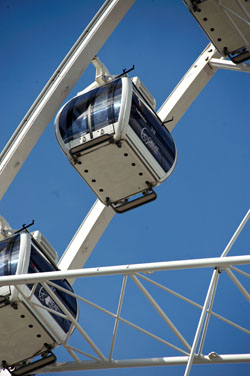Nikon AF-S Nikkor 28-300mm f/3.5-5.6G ED VR
 |
| Is Nikon's new 28-300mm the ideal travel lens for FX format cameras? Here Gary Wolstenholme puts the lens through its paces. |
Nikon's latest superzoom optic offers a convenient 10.7x zoom range covering wide angle to super-telephoto, Vibration Reduction and a fast silent wave focusing motor all for around £870, which seems a little steep to me. It promises to be a one lens solution suitable for FX format camera owners who wish to travel light, or even simply as a useful 'walkabout' lens to complement your existing kit.
The only third party manufacturer currently offering a comparable alternative is Tamron. Their 28-300mm f/3.5-6.3 VC Di also offers Vibration Compensation, but lacks the silent focusing motor found on the Nikon. The maximum aperture is a third of a stop slower at 300mm also, being f/6.3 rather than f/5.6 as found on the Nikon. As it only costs around £500, which is about £370 less, I'm sure many would be able to overlook this shortcoming if the performance is similar.
Nikon AF-S Nikkor 28-300mm f/3.5-5.6G ED VR: Handling and features
The first thing that struck me about this lens is its size. It's certainly not a small lens for its type and can look quite imposing with the petal shaped hood attached. It takes standard 77mm filters via the front thread, which will please those looking for a walkabout lens to accompany their professional short zooms.
The lens construction and finish is typical of Nikon's latest generation mid-level consumer zooms, with the zoom ring placed furthest from the body and a slimmer focus control placed nearer the camera. A distance scale sits between these controls but is lacking a hyperfocal scale. I suppose it would be impossible to provide a scale that works well with the zoom range covered though. Even though it looks similar to other consumer grade lenses, the lens weighs 800g, and feels reassuringly solid as a result.
Focusing is performed internally so the front element doesn't rotate during focus or zoom operations. This will suit users of polarising filters perfectly. In use the focus speed is quick for most subjects in good light. In low light the lens occasionally hunts when shooting at the 28mm and 300mm extremes, but I was still impressed with its overall focus speed.
The Vibration Reduction system found on this lens is the new generation that promises to allow sharp shots to be taken at shutter speeds 4 stops slower than what would be possible without. In use I found sharps shots are achievable at 300mm and 1/30sec with some degree of consistency, and even at 1/15sec about half the time, which will certainly make this lens a viable option when travelling light.
Nikon AF-S Nikkor 28-300mm f/3.5-5.6G ED VR: Performance
Lenses with such a high zoom range like this are often a bit of a compromise optically. Despite this the 28-300mm put in a respectable performance as far as resolution is concerned. Shooting wide open at 28mm, images have good resolution in the centre and are acceptable towards the edges. Stopping the lens down a little increases the resolution right across the frame, with peak performance being between f/8 and f/11 where the sharpness in the centre is very good, and good towards the edges too.
Zooming the lens in a little actually appears to improve the performance at wider apertures a little. At 105mm the centre resolution is very good at the maximum aperture of f/5.3. Again peak quality across the frame is found somewhere between f/8 and f/11 where image display very good sharpness in the centre and good resolution towards the edges.
Compared to other lenses covering a similar zoom range, this lens puts in a very respectable performance at 300mm. At f/5.6 the resolution in the centre is already good and the performance is quite acceptable towards the edges. This is a good sign as lenses like this tend to be shot at maximum aperture at the long end much of the time. Peak performance at 300mm is found at f/8 where the sharpness in the centre is just a shade better than at f/5.6. At smaller aperture diffraction seems to have an effect on sharpness, but the performance will still be acceptable for most right down to f/22.
For the most part Chromatic Aberrations are kept below acceptable levels. They are at their worst at 28mm where Imatest recorded colour fringes covering 0.8 pixel widths towards the edges of the frame, which may become apparent in areas of high contrast such as tree branches against an overcast sky, but is still of low enough a level to pose few issues.
At 28mm falloff of illumination towards the corners of the image area is pretty well controlled. At maximum aperture the corners are 1.13 stops darker than the image centre and stopping the lens down to f/5.6 produces visibly uniform results. At 300mm the level of falloff towards the corners increases slightly. At f/5.6 the corners are 1.68 stops darker than the image centre and the lens needs to be stopped down to f/11 for visibly uniform illumination.
Distortion is often the Achilles heel of superzoom lenses such as this. At 28mm Imatest recorded 6.81% barrel distortion, which is quite a pronounced level, which will pose problem is straight lines on subjects such as architecture are important. At 300mm 2.09% pincushion distortion is present, which won't pose too much of an issue for many subjects, but will be noticeable in certain situations. Luckily the distortion pattern is uniform, so it should be easy enough to correct the effect in image editing software afterwards if needs be.
Although this lens doesn't sport Nikon’s Nano Crystal coating technology, it performs reasonably well when it comes to resisting ghosting and flare. Point sources of light within the frame will cause a little flare and loss of contrast in some situations, whereas light sources outside the frame may cause a slight loss of contrast if it catches the front element. A petal shaped lens hood is provided which does a great job of shielding the lens from extraneous light at shorter focal lengths, but is maybe a little short to provide adequate protection through the zoom range. This is unfortunately one of the compromises of such a large zoom range in one lens, and can't really be helped.
 | DxOMark provides objective, independent, RAW-based image quality performance data for lenses and digital cameras to help you select the best equipment to meet your photographic needs. Visit the DxOMark website for tests performed on the Nikon AF-S Nikkor 28-300mm f/3.5-5.6G ED VR. |
Nikon AF-S Nikkor 28-300mm f/3.5-5.6G ED VR: Verdict
If you're the proud owner of an FX format Nikon camera and are looking for something that gives you this kind of convenience for travel or simply to compliment your existing kit then this lens is certainly worth a look, that is if you've nearly £900 to spare.
The price may seem a little steep, but it does perform very well for a lens of this type. Plus there are currently no alternatives offering this kind of flexibility with silent focusing, vibration reduction and an aperture of f/5.6 at 300mm. All these features will obviously come at a premium, how much of a premium you can personally justify will be down to you.
Nikon AF-S Nikkor 28-300mm f/3.5-5.6G ED VR: Pros
 Good optical performance for a lens of this type
Good optical performance for a lens of this type Fast silent focusing
Fast silent focusing Vibration reduction is very effective
Vibration reduction is very effective Build quality
Build qualityNikon AF-S Nikkor 28-300mm f/3.5-5.6G ED VR: Cons
 Maybe a bit on the pricey side
Maybe a bit on the pricey side Distortion at 28mm and 300mm
Distortion at 28mm and 300mm| FEATURES |  |
| HANDLING |  |
| PERFORMANCE |  |
| VALUE |  |
| OVERALL |  |
Nikon AF-S Nikkor 28-300mm f/3.5-5.6G ED VR: Lens specification
| Price | £870.00 |
| Contact | www.nikon.co.uk |
| Filter size | 77mm |
| Format | Full-frame |
| Construction | 19 elements in 14 groups |
| Angle-of-view | 75˚-8˚10’ (53˚ - 5˚20’ in Nikon DX format) |
| 35mm equivalent focal length (on APS-C body) | 42-450mm |
| Internal focusing | Yes |
| Image stabilisation | Yes |
| Minimum focus | 50cm |
| Maximum aperture | f/3.5-5.6 |
| Minimum aperture | f/22-38 |
| Weight | 800g |
| Size | 114.5 x 83mm |
| In the box | CL-1120 Lens Pouch, HB-50 lens hood. |
The Nikon AF-S Nikkor 28-300mm f/3.5-5.6G ED VR costs around £870 and is available from Warehouse Express here:
Nikon AF-S Nikkor 28-300mm f/3.5-5.6G ED VR
Add your message
Login required
Please login here or if you've not registered, you can register here. Registering is safe, quick and free.
Please login here or if you've not registered, you can register here. Registering is safe, quick and free.
photodo Stats
1102 lenses
428 MTF tests
74 in-depth photodo reviews
100+ users join each day
Help the lens community by reviewing or rating a lens today via our lens search
428 MTF tests
74 in-depth photodo reviews
100+ users join each day
Help the lens community by reviewing or rating a lens today via our lens search
Latest Lens Reviews
- Chinon 28mm f/2.8 Vintage Lens Review
- Canon EF 70-200mm f/4L IS II USM Lens Review
- Samyang AF 85mm f/1.4 EF Review
- Sigma 70mm f/2.8 DG Macro Art Review
- Samyang AF 24mm f/2.8 FE Review
- Meike 50mm f/1.7 Review
- Tamron 70-210mm f/4 Di VC USD Review
- Lensbaby Burnside 35mm f/2.8 Review
- Asahi Super Takumar 50mm f/1.4 Review
- Asahi Super-Multi-Coated Takumar 135mm f/3.5 Review










